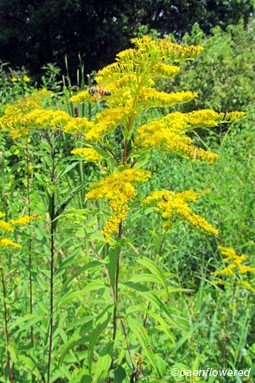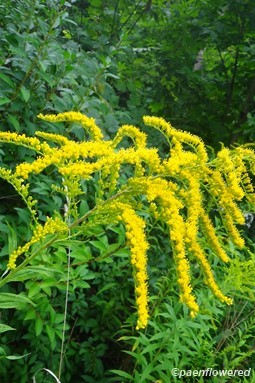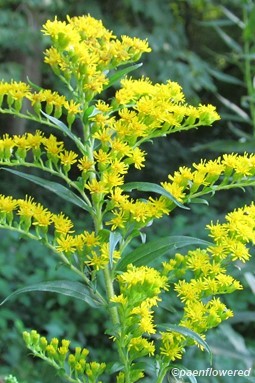Solidago canadensis
A common goldenrod with a plume-like flower cluster
Solidago canadensis Canada goldenrod
There are about 30 different native goldenrod species that bloom during the summer and fall in this region. Many of them look much alike except for the fine details of their flowers, stems, and leaves. Distinguishing them can be a challenge. Several species have their flower clusters in plumes like this one. The Canada goldenrod, like the similar early goldenrod, is one of the earlier blooming members of the goldenrod genus. It has parallel veins in its leaves and a plume-like flower cluster like many of our taller goldenrod species. All goldenrods are members of the Aster family. The leaves of this species are dense, usually smooth, and with very small, sharply toothed edges. There are 3 veins per leaf and the leaves lack petioles.
The tiny yellow individual composite flowers have 9-15 ray florets. Each flower is only about 1/8 inch long. The green bracts at the base of the flowers are long, thin, and pointed. The flowers are arranged on one side of the spreading branches at the top of the plant. The plant grows 1-5 feet tall along roadsides and streams and in thickets and clearings. The stem is usually smooth at the bottom but may be downy at the top.
This species is found in eastern and central Canada as well as the northeastern quarter of the United States. Canada goldenrod tends to form clumps as it spreads by underground rhizomes or runners. The blooming period is July to September. A similar early goldenrod (S. juncea) has feather veins. Both species may have smaller leaves growing from the axils of the larger leaves, though this is more common in the early goldenrod. The Canada goldenrod can also be easily mistaken for the late goldenrod and the tall goldenrod that have similar features. The genus name Solidago is derived from the Latin word solidus which means "whole". This reflects their medicinal use as in "to make whole".
Habitat & Range
Grows in fields and along roadsides.
Present throughout the state.
| EMP: | FACU |
|---|---|
| NCNE: | FACU |
Phenology
Flowers July to October.
Plant Codes
S-rank: S5 (Secure)
G-rank: G5 (Secure)















Comments
Have you spotted this plant in your area? We'd love to hear about your experience! Share your comments or questions about the plant below. Comments are moderated before posting.